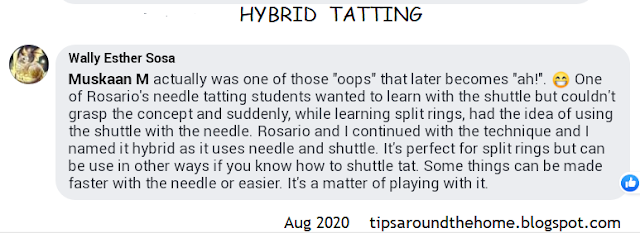my musings.....
This is somewhat of a personal deliberation, contemplation - musings if you may. I haven't done a thorough exploration. So jump in with your comments, input, counter, reference, etc.
We know that any tool we use for tatting lace has it's advantages and limitations. Ingenious tatters have found ways to use the strengths of each tool Together!
Hybrid Tatting is a tatting method that uses both needle and shuttle to work an element. It started with using them together in a split ring as seen in the image above. The term was coined by Wally Esther Sosa, for this method by Rosario Ruiz Moreno. They taught it at Palmetto Tat Days in 2017. Wally narrated the genesis -
I first came across this term and clever adaptation last year when Sharon Fawns blogged about it here.
Recently, someone shared a video on facebook, that clearly showed how to do the split ring in hybrid tatting. It was dated 2015! It is by ChariFriv and can be accessed through this link - https://www.facebook.com/charifriv/videos/1602794246605932. Another example of how tatters independently came up with the same technique, method, or effect!
UPDATE (Nov 2022) - Wally tells me that ChariFriv is Rosario Ruiz Moreno!
Anyway, this got me thinking.
Should the term hybrid tatting be limited to the use of 2 tools for the same element or can it include the use in separate elements or rows within the same lace?
A pattern that comes to mind is Frivolé's Rose and Crown motif. It has interlocking rings as the central round and several shuttle tatters use a needle to tat only this round.
And what about the SSSR (single shuttle split ring) where we use shuttle to tat 1st side and finger to tat the other?! 2 tools in same element.
3 mock chains completed with picots.
Buttonhole Stitch -
These are merely a small window into the use of 2 tools specifically for tatting the same element, separate elements or rows in the very same tatted lace. I deliberately omitted several other ways we use a crochet hook, a needle, or a cro-tatting tool, focusing only on how a false/mock stitch can be made with 2 tools such that once the lace is completed, the difference in tools is not apparent or discernible.
So, what are your thoughts? Where, and how would you use 2 tools to ease your tatting; and which 2 or more tools?











I have absolutely no experience of needle tatting. There were patterns in Anna Burda where they tatted a square and then filled it with needle lace. I think such combinations can help achieve a desired effect. The purists don’t like it though. Those competition judges would have a fit.
ReplyDeleteOh yes, Jane, I totally forgot about that - I've done it in a couple of motifs for practice and blogged, too, Oops!
DeleteYou are right about purists and judging. Would they still know, if not told ;-P
Needle tatter (Gloria) told me she used a shuttle to make the floating rings on a doily she made. It was used in place of the cut thread that would have been needed to put true rings on top of the chains.
ReplyDeleteFloating rings are certainly easier and probably neater to tat with shuttle, Sharon! Thank you for sharing this :-)))
DeleteWow! Too much to learn!! Great lessons and observations!!! :) Thank you for sharing all the information and discoveries you have found!! ;)
ReplyDeleteIt is my way of keeping track of the vast expanse of tatting knowledge, Sue ;-D
DeleteThank you a lot for another great lesson, I saw the video in fb and I have been wondering when the use of needle and shuttle together in split rings had started. I agree with Shelley Perreault when she wrote in her blog that "a knot cares not how it's made".
ReplyDeleteSo true, Nin, unless one enters the piece in a competition perhaps ;-P
DeleteI wanted the resources together, hence this post :-))
Wow this is a great post and very interesting, I have been doing some embroidery and did blanket stitch so I think I will be trying that out soon, I learnt blanket stitch many moons ago never thought of incorporating it into tatting, You just keep us going with new thoughts and ideas
ReplyDeleteMargaret, we used to call it blanket stitch, too! But in Elgiva's book, she says buttonhole and I went with it. I loved the decorative blanket stitches which created a V or even a V with a vertical line in the center.
DeleteThank you :-)))
Great minds think alike!!! In this case: you and stitchers I have been meeting with in the next town over. They have asked me to teach them tatting in exchange for teaching me embroidery. I haven't learned much and am still working very simple projects. But, they combine technique all over the cloth!
ReplyDeleteYou express it so well. I'll be sharing your post with them. Thank you!!!
Wow, thanks, Mel :-))) Brazilian embroidery resembles tatting a lot. In fact, the 'half stitches' are made over a needle just like in needle tatting, and creates beautiful 3D petals, etc.
Delete